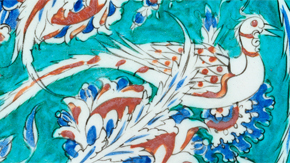Closed Exhibition - Russian Avant-garde Theatre
Russian Avant-garde Theatre: War Revolution and Design 1913 – 1933 - About the Exhibition

El Lissitzky: Costume design for the Sportsmen from the portfolio “Die Plastische Geschtaltung der Elektro-Mechanischen Schau “Sieg über die Sonne” for Victory over the Sun (unrealised), 1923. Lithograph on paper. St. Petersburg Museum of Theatre and Music, St. Petersburg
El Lissitzky: Costume design for the Sportsmen from the portfolio “Die Plastische Geschtaltung der Elektro-Mechanischen Schau “Sieg über die Sonne” for Victory over the Sun (unrealised), 1923. Lithograph on paper. St. Petersburg Museum of Theatre and Music, St. Petersburg
Created over the course of two decades marked by the Russian revolutions and First World War, the works represented an extraordinary point in Russian culture during which artistic, literary and musical traditions underwent profound transformations. New types of theatrical productions demanded innovative design solutions and benefitted from the unprecedented symbiosis of artists, musicians, directors and performers which characterized the period. Artists who worked in a variety of mediums including painting, architecture, textiles, photography and graphics worked collaboratively on theatrical productions to create a rich variety of design. For the avant-garde this work in theatrical innovation came to inform wider artistic practices.
The display started with the set and costume designs by the prominent painter Kazimir Malevich. On view were sketches and lithographs for Victory Over the Sun, a Futurist opera which premiered in 1913 in St Petersburg. Malevich designed backdrops made from cloth sheets printed with monochrome graphic forms. A design for one scene depicts a large black and white square divided diagonally. The concept for the set is a forerunner of Malevich’s renowned non-representational painting Black Square (1915), a work which embodies the aesthetics of the Suprematist movement originated by the artist. The sketches which were on display at the V&A illustrate the earliest examples of Suprematism. Malevich’s costume designs for Victory Over the Sun were on view and show voluminous creations in bold colours which reshape the human figure. The prodigious artist and photographer Alexander Rodchenko was also represented. For Vladimir Mayakovsky’s satirical play The Bedbug (1929) Rodchenko designed radically futuristic ensembles featuring wide silhouettes and breathing apparatus to convey men from later decades. A series of costume designs for We (1920), a Proletcult Theatre production that was eventually banned by the authorities, were characterized by Rodchenko’s use of bold geometric form and bright colour.
Works on display by Liubov Popova included a maquette for a set model for The Magnanimous Cuckold (1922), a farce by Fernand Crommelynck performed at the radical Meyerhold Theatre. Popova’s set design was comprised of a mechanical mill, wheels and conveyer belts and provided a backdrop fordirector Vsevolod Meyerhold to present his acting theory of biomechanics, which favoured gesture and movement over psychological interpretation. A dozen examples of work by the influential theatrical designer Alexandra Exter for ballet, opera and plays were also included. Exter was known for the austerity of her designs and use of lighting rather than physical structure to construct sets. On display was a set model, stage and costume designs for Salome, performed at The Camerny Theatre in 1917, as well as costume design for alien beings for the 1924 Soviet science fiction film Aelita: Queen of Mars. Designs for stage by the renowned film director and theorist Sergei Eisenstein, known for pioneering work in the practice of montage in film, were also on display.
The works on display in Russian Avant-Garde Theatre: War, Revolution and Design, 1913 – 1933 were drawn primarily from the A. A. Bakhrushin State Central Theatre Museum (Moscow) and St. Petersburg State Museum of Theatre and Music.

Contents
A gift in your will

You may not have thought of including a gift to a museum in your will, but the V&A is a charity and legacies form an important source of funding for our work. It is not just the great collectors and the wealthy who leave legacies to the V&A. Legacies of all sizes, large and small, make a real difference to what we can do and your support can help ensure that future generations enjoy the V&A as much as you have.
More